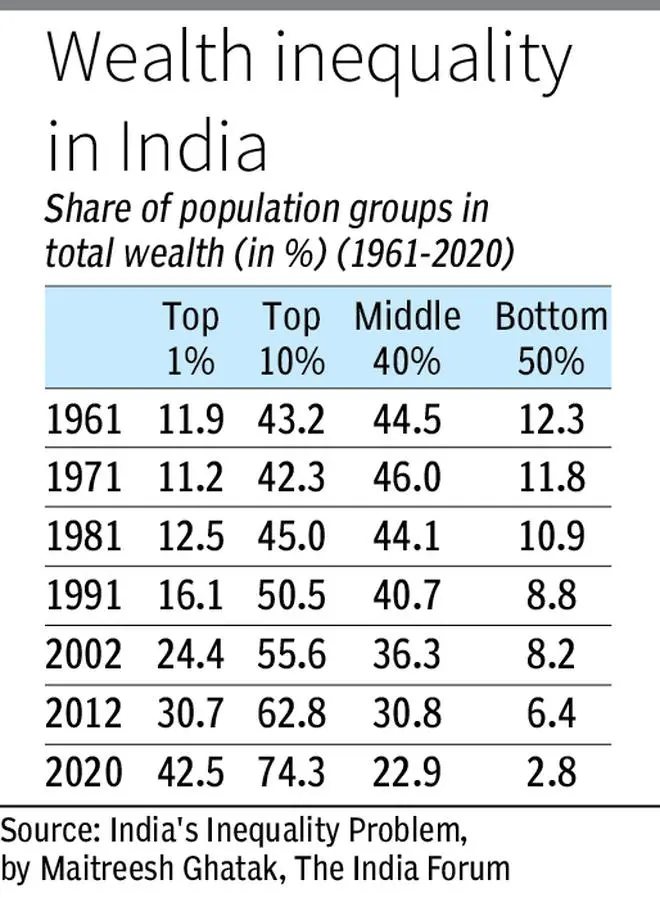When the topic of ESG (Environment Society and Governance) is raised, the immediate response of companies is to think of E and talk about all the efforts that they are doing or going to do on Environment. It is also a standard assumption that the subject company is also excellent on Governance and hence they only need to address E.
While it is true that global warming is something that all of us are facing and hence there is a better understanding of the need to focus on E, there is equally the need to think of S. Society is usually ignored and it is assumed to be CSR or board gender diversity (which they meet for statutory purposes).
It is important to address S given the growing inequity and discrimination in the world and in India. If left unaddressed this could become a serious concern. Growth in corporate wealth is leading to income and wealth inequality worldwide. India is also seeing a significant growth in inequality as can be seen from the Table.

The obvious response is that governments and civil society should address this, and corporates have other things to focus on. This is no longer true. The largest corporations control large portion of the global assets, employ a huge number of people directly and indirectly impact several more through their supply chains.
They also supply goods and products directly or indirectly to most of the world’s population.
The concentration of economic power also leads to a disproportionate ability to influence policy and society. The long term survival of corporates (their markets primarily) will be severely impacted if they do not address ESG issues either due to global warming or through inadequate income due to income disparities or worse social unrest driven by the inequities. Hence it is critical that corporates look at ESG not just as something that investors are demanding but as their long term survival need.
The Society in ESG relates to the impact of the corporation on its immediate and the larger social milieu that it operates within. It covers employee diversity, reducing discrimination, employee safety and health, health and safety of its supply chain employees, sourcing from ethical sources, data protection and privacy, product impact on society, land use and impact on ethnic communities, impact on animal rights, relation with local communities, etc.
This article focuses on the employee dimension. The premise is that social harmony can be promoted by ensuring better opportunities to all sections of the society and reducing compensation and other forms of discrimination.
What can India Inc do?
SEBI has directed that the top 1000 companies disclose ESG related data using the Business Responsibility and Sustainability Reporting Framework. However, companies are not limited to disclosing only what is demanded but can go beyond and set benchmarks for others to follow.
Once the leaders start disclosing on other parameters, especially voluntarily, they will be rewarded by investors and others and become a source of competitive advantage.
A classical example is the way Infosys influenced and drove reforms on corporate governance in India.
Here are some employee related information that corporates can consider disclosing voluntarily.
(a) A key disclosure that is now required is that of the ratio of compensation between the highest and lowest paid employees. Corporates can provide commentary on how they will reduce this gap over a period. In addition, they can disclose similar ratios with respect to contract employees and others in their supply chain. Where we have owner managers the owners also compute a ratio where they include the dividend with the salary for the numerator.
This reduces the distortions in such computations where dividend is preferred to salary for tax reasons.
(b) Companies are required to disclose the number of permanent employees and non-permanent employees classified into men, women and differently abled employees broken up between officers and workers. Corporates can start disclosing their employee composition on other dimensions — example, state of origin, mother tongue, rural versus urban background, religion, social status (SC/ST), etc — and work towards improving the composition in line with their region or country.
(c) Similarly, changes in employee composition — example, additions and exits for current and past years — can be disclosed not just on the three dimensions and two categories but on all the other dimensions mentioned in (b).
(d) Companies are required to disclose gender differences in compensation. Corporates can go one step further and think of compensation differences across the dimensions in (b).
(e) Corporates are required to train people on human rights. They could train everyone on ethics, integrity and core principles of the Constitution, etc., and provide disclosure on how they are being model corporate citizens.
More such items can be thought through and disclosed.
Social harmony is a key requirement for long term prosperity of corporates and it is in their interest to promote this.
The writer is Managing Director at ECube Investment Advisors, an ESG focused financial services company





Comments
Comments have to be in English, and in full sentences. They cannot be abusive or personal. Please abide by our community guidelines for posting your comments.
We have migrated to a new commenting platform. If you are already a registered user of TheHindu Businessline and logged in, you may continue to engage with our articles. If you do not have an account please register and login to post comments. Users can access their older comments by logging into their accounts on Vuukle.